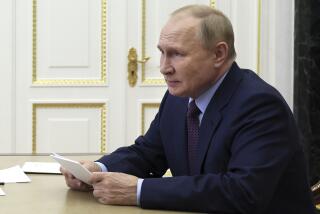CIA Scrambles to Evaluate Breakaway Soviet Republics : Intelligence: Director Gates tells his agency analysts to focus on monitoring leaders in the newly independent states.
- Share via
WASHINGTON — The CIA, admittedly ineffective in forecasting many recent Soviet events, has begun what officials call a “feverish” effort to expand its sources and analytical depth in the fragmenting republics and to get a grasp on the crumbling superpower’s future.
As one of his first acts in response to the dismantling of the Soviet Union, new CIA Director Robert M. Gates last week abolished the agency’s Soviet Foreign Policy Group and has ordered its analysts to concentrate on monitoring foreign policy leaders in the newly independent republics, particularly in Boris N. Yeltsin’s Russian Federation.
“With the weakening of the union, there’s been much less need for analysis of Soviet foreign policy,” an agency official said. “But in terms of Russian foreign policy, there’s great interest among (American) policy-makers.”
The agency also is scrambling to produce at least 10 new intelligence estimates on the breakup of the Soviet Union and the evolving power structure. Reports are being prepared on the dissolution of the armed forces, control over nuclear weapons and technology, ethnic tensions in the republics, food and fuel shortages, economic stagnation and the potential for civil disorder.
The estimates were the basis of Gates’ extraordinarily gloomy assessment before Congress on Tuesday that the disintegrating Soviet Union could face unprecedented civil disorder this winter growing from pervasive shortages, a breakdown in authority and deep ethnic tensions.
Some of the studies Gates ordered, known as “national intelligence estimates,” already have been submitted to the White House and other government offices and now are being revised because their findings have been overtaken by events, sources said.
The CIA and the State Department also are attempting to strengthen the corps of analysts assigned to the U.S. Embassy in Moscow, where the pace of events has left the staff breathless, officials said.
U.S. Ambassador to Moscow Robert S. Strauss complained Tuesday that the embassy is hobbled by the remnants of Cold War security procedures and a shortage of qualified intelligence officers. “We have a terribly inefficient embassy operation over there,” Strauss told a group of American experts on the Soviet Union in Washington. “We’re short on economic talent and we’re short on political talent and we’re long on security talent.”
A related problem is a dearth of experts on the more obscure republics, intelligence specialists said. When such Central Asian republics as Kazakhstan, Kyrgyzstan (formerly Kirghizia), Tadzikhistan, Turkmenistan and Uzbekistan were part of a Moscow-controlled union, their language, culture and history were of minor importance to U.S. government officials.
But as the dissolution of the center spins them into greater autonomy, they become of critical importance because of their internal strains and because of their location along the borders of Turkey, Iran, Iraq, China and Afghanistan, officials said.
“They (intelligence officials) are really having trouble getting skilled people in these various republics,” one ex-CIA Soviet analyst said. “They have a huge number of people who can tell you anything you want to know about the Soviet military, but there is very little political knowledge and language ability on the Asian republics.”
A State Department official said the department had hoped to create consulates in a number of the regional capitals this year but the plan has been stalled by a lack of funds.
Instead, the Moscow embassy has instituted a “circuit rider” program in which Moscow-based diplomats will travel regularly to the republics; even that has been slow getting under way.
“We don’t have a lot of people who speak the languages of all those places,” said one official. “We hope to have the program running fully some time next year.”
A CIA spokesman said Wednesday that the agency created a crisis monitoring cell for the Soviet Union last December, when Foreign Minister Eduard A. Shevardnadze resigned, warning of an impending right-wing coup, and when tensions escalated in the Baltic republics. The crisis group has expanded and contracted as events warranted, the spokesman said. It is now at full strength.
“Everyone has picked it up a few notches,” said spokesman Mark Mansfield. “Our Soviet experts have never been busier, nor has the interest in their work been more intense throughout the government. . . . This is one that really counts.”
In March, the CIA created two new divisions within the Office of Soviet Analysis to reflect the fracturing of the union. One, known as the Russia/Union division, focuses on the core Russian Federation and the rapidly evaporating center. The second, the Republics Division, attempts to keep up with events in the other republics.
Times staff writer Doyle McManus contributed to this story.
More to Read
Sign up for Essential California
The most important California stories and recommendations in your inbox every morning.
You may occasionally receive promotional content from the Los Angeles Times.










